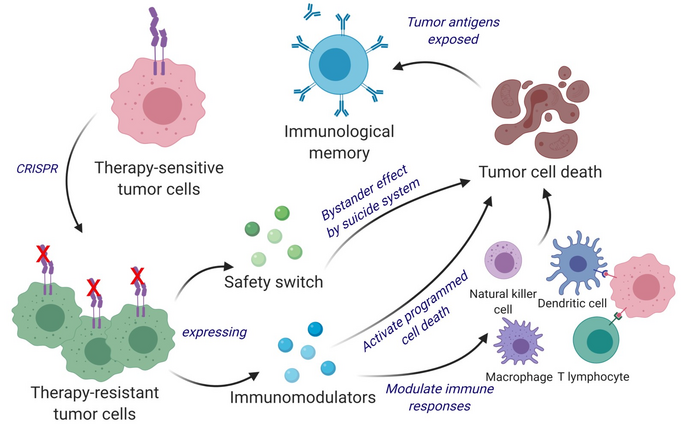Jan 05 2023
Using Tumor Cells to Kill Tumors
 We are living in the future, at least the future I imagined 30 years ago when I was beginning my medical career. At the time I learned about a lot of new technologies that were only in the proof-of-concept or research phase, but there was a lot of enthusiasm about their potential. As often happens, translating those technologies into therapeutics took longer than we hoped, but now that they are hitting they are more powerful than we dreamed.
We are living in the future, at least the future I imagined 30 years ago when I was beginning my medical career. At the time I learned about a lot of new technologies that were only in the proof-of-concept or research phase, but there was a lot of enthusiasm about their potential. As often happens, translating those technologies into therapeutics took longer than we hoped, but now that they are hitting they are more powerful than we dreamed.
We now live in a world where there are monoclonal antibody therapeutics for many diseases, changing almost every field of medicine. We are starting to do real gene therapy to cure or mitigate genetic diseases. We have harnessed immune cells in order to target them against cancers. We are also at the beginning of hacking the brain with electrical and magnetic interventions to treat pain, seizures, movement disorders, and other conditions. These are all powerful approaches that are transforming medicine. They are not just incremental advances, such as developing a new drug, but entirely new methods of treatment that open up new possibilities.
I now read news items on a regular basis about such new treatments. One that caught my eye recently was just published in Science: Translational Medicine – Bifunctional cancer cell–based vaccine concomitantly drives direct tumor killing and antitumor immunity. This is a study in mice, so there are years of research before this approach hits the clinic, but it shows the potential of our existing technology.
The study was performed in humanized mice. It may be easy to skip over that tidbit of information, but I want to highlight how amazing that small fact is. The researchers used genetic engineering technology to create mice that have a human-like immune system, with human-derived liver, bone marrow, and thymus tissue. This makes it easier to translate the results to humans. This represents the application of biotechnology to research itself, a feedback loop that is accelerating the power and pace of biotech advancement. It’s seriously getting hard to keep up.
Already we are using deactivated tumor cells in order to target the immune system against a cancer. Cells taken from a tumor partly removed from a patient are engineered to be inactive but also to maximally stimulate the immune system against the tumor itself. This acts like a vaccine against the cancer, which is mostly used to prevent recurrence from any cancer cells that escape the initial round of treatment.
What the current researchers did was use live tumor cells, in this case from a glioblastoma (the deadliest form of brain cancer). Live tumor cells have a tendency to seek out and join with other cells from the same tumor. The researches liken this to a guided missile. This allows them to used these altered cancer cells to deliver a payload that will kill cancer cells. The researchers used CRISPR-Cas9 to make the alterations – another example of a recent biotechnology that is having ripple effects throughout medical research. They call these altered cells engineered therapeutic tumor cells (ThTCs). Specifically:
We repurposed the tumor cells from interferon-β (IFN-β) sensitive to resistant using CRISPR-Cas9 by knocking out the IFN-β–specific receptor and subsequently engineered them to release immunomodulatory agents IFN-β and granulocyte-macrophage colony-stimulating factor.
The effect was to induce apoptosis in living cancer cells – spontaneous cell death. In the mouse models this lead to elimination of the established tumors. This by itself is not a complete cure as there are likely cancer cells that survive. This is why they also engineered the ThTCs to express proteins that would target the host’s immune system against the glioblastoma cells – that is the cancer vaccine approach. This way the immune system is beefed up against any surviving cells, hopefully preventing them from establishing any new tumors.
The obvious risk, and the reason this will have to be extensively researched, is that injecting live cancer cells into a patient can potentially seed new tumors. For that reason the researchers also included a double kill-switch into the ThTCs. One is a “rapamycin-activated caspase 9” – so when the job is done they can give the patient rapamycin which will kill any ThTCs still alive.
If all this sounds risky, that’s because it is. But everything in medicine is a risk vs benefit. Unfortunately, glioblastoma is an aggressive form of brain cancer that is usually terminal, even with modern treatments. That justifies a lot of risk and giving very aggressive treatments if they have any chance of significantly extending life or even achieving remission. But so far the treatment does appear safe in the mice that were studied, and hopefully will prove relatively safe in humans (providing more benefit than risk).
This is just one snapshot of the kind of research that is now underway in countless labs. The availability of practical biotechnology like CRISPR-Cas9 is delivering on the hype.






